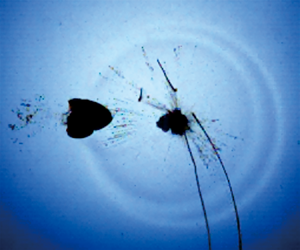Crossref Citations
This article has been cited by the following publications. This list is generated based on data provided by
Crossref.
Li, Shi-Min
Liu, Yun-Long
Wang, Qianxi
and
Zhang, A-Man
2021.
Dynamics of a buoyant pulsating bubble near two crossed walls.
Physics of Fluids,
Vol. 33,
Issue. 7,
Lu, Xiang
Chen, Chen
Dong, Kai
Li, Zefa
and
Chen, Jiankang
2021.
An equivalent method of jet impact loading from collapsing near-wall acoustic bubbles: A preliminary study.
Ultrasonics Sonochemistry,
Vol. 79,
Issue. ,
p.
105760.
Chen, Yingyu
Yao, Xiongliang
Cui, Xiongwei
and
Gou, Yuxin
2021.
Experimental investigation of bubble dynamics near a double-layer plate with a circular hole.
Ocean Engineering,
Vol. 239,
Issue. ,
p.
109715.
Zhai, Yanwei
Xu, Weilin
Luo, Jing
and
Li, Jianbo
2022.
Experimental study on the characteristics of microjets and shock waves of cavitation bubbles near elastic boundaries.
Ocean Engineering,
Vol. 257,
Issue. ,
p.
111664.
Peng, Yiyun
He, Xiaolong
Peng, Haonan
Lin, Yuqing
and
Zhang, Jianmin
2022.
Mesoscopic modeling of vapor cavitation bubbles collapse and interaction in near-wall region with a pseudopotential lattice Boltzmann method.
Physics of Fluids,
Vol. 34,
Issue. 9,
LIU, Xuechun
BAI, Ruidi
WANG, Hang
and
LIU, Shanjun
2022.
Flow aeration by an offset aerator: Air entrainment, bubbly flow turbulence, and adaptive-window cross-correlation processing.
Experimental Thermal and Fluid Science,
Vol. 132,
Issue. ,
p.
110572.
Li, Jian-Bo
Xu, Wei-Lin
Zhai, Yan-Wei
Luo, Jing
Wu, Han
and
Deng, Jun
2022.
Experimental study of the collapse strength of a bubble merged from a spark-induced bubble and a pre-existing air bubble.
Ocean Engineering,
Vol. 249,
Issue. ,
p.
110907.
Phan, Thanh-Hoang
Kadivar, Ebrahim
Nguyen, Van-Tu
el Moctar, Ould
and
Park, Warn-Gyu
2022.
Thermodynamic effects on single cavitation bubble dynamics under various ambient temperature conditions.
Physics of Fluids,
Vol. 34,
Issue. 2,
Wang, Qing-feng
and
Wei, Wang-ru
2022.
Experimental research on the effect of air bubble properties on aluminum cavitation erosion.
AIP Advances,
Vol. 12,
Issue. 3,
Chen, Si-Yu
Xu, Wei-Lin
Luo, Jing
Li, Jian-Bo
and
Zhai, Yan-Wei
2022.
Experimental study on the mesoscale causes of the effect of sediment size and concentration on material cavitation erosion in sandy water.
Wear,
Vol. 488-489,
Issue. ,
p.
204114.
Bai, Rui-di
Zhang, Fa-xing
Wang, Wei
and
Liu, Shan-jun
2022.
Air concentration distribution in the impact zone of spillway aerator.
Journal of Hydrodynamics,
Vol. 34,
Issue. 1,
p.
156.
Lyubimova, T.
Rybkin, K.
Fattalov, O.
Kuchinskiy, M.
and
Kozlov, M.
2022.
Investigation of Generation and Dynamics of Microbubbles in the Solutions of Anionic Surfactant (SDS).
Microgravity Science and Technology,
Vol. 34,
Issue. 4,
Bian, Zhendong
Wang, Jingzhu
Yin, Bo
Wang, Yongjiu
Qiu, Rundi
Wang, Yiwei
and
Du, Tezhuan
2022.
Studies on two-bubble energy transfer model with radiant-receiver structure.
Acta Mechanica Sinica,
Vol. 38,
Issue. 11,
Pan, Jinghan
Tu, Chengxu
Chen, Taohou
Xia, Xufeng
Du, Pengfei
Bao, Fubing
and
Lin, Jianzhong
2023.
Non-spherical collapse of a cavitation bubble induced by a rigid filament.
Ocean Engineering,
Vol. 287,
Issue. ,
p.
115838.
Wei, Zhenjiang
Zhang, Chengchun
Shen, Chun
Wang, Lin
and
Xin, Zhentao
2023.
Manipulation of bubble collapse patterns near the wall of an adherent gas layer.
Ultrasonics Sonochemistry,
Vol. 101,
Issue. ,
p.
106722.
Han, Rui
Chen, Jiayi
and
Guo, Taikun
2023.
A Modified Phase-Transition Model for Multi-Oscillations of Spark-Generated Bubbles.
Inventions,
Vol. 8,
Issue. 5,
p.
131.
Qiu, Ning
Zhu, Han
Xu, Pei
Che, Bangxiang
Wu, Jie
Zhou, Wenjie
and
Wang, Chuan
2023.
Assessment of cavitation erosion risk indicated by pressure impact exceeding material strength threshold.
Physics of Fluids,
Vol. 35,
Issue. 9,
Zou, Lingtao
Luo, Jing
Xu, Weilin
Zhai, Yanwei
Li, Jie
Qu, Tong
and
Fu, Guihua
2023.
Experimental study on influence of particle shape on shockwave from collapse of cavitation bubble.
Ultrasonics Sonochemistry,
Vol. 101,
Issue. ,
p.
106693.
Liu, Xuechun
Bai, Ruidi
Liu, Shanjun
and
Tian, Zhong
2023.
Bottom and side-wall aeration performance of an offset aerator in a flood discharge chute.
Proceedings of the Institution of Civil Engineers - Water Management,
Vol. 176,
Issue. 6,
p.
303.
Wang, Jia-xia
Wu, Shi-zeng
Liu, Kun
Jiang, Ming-zuo
and
Wang, Zi-li
2023.
Experimental Study on Effect of Inclination Angle on Bubble Collapse near Attached Air Bubble.
China Ocean Engineering,
Vol. 37,
Issue. 5,
p.
753.

 $\alpha $ formed by the air bubble, cavitation bubble and the measuring point, would jointly affect the attenuation of the pressure peak and energy of the shock wave. Quantitatively, the attenuation magnitude was proportional to
$\alpha $ formed by the air bubble, cavitation bubble and the measuring point, would jointly affect the attenuation of the pressure peak and energy of the shock wave. Quantitatively, the attenuation magnitude was proportional to  $a{(\alpha \varphi /\varepsilon )^b}$, where the values of the coefficients a and b depended on whether the shock wave was stratified or not. When the cavitation bubble and the air bubble merged, the energy and the pressure peak of the shock wave decreased to less than 40 % of the values in the absence of the air bubble. With the new insight into bubble–bubble interaction mechanisms, the findings will facilitate a better understanding and development of cavitation utilization and prevention technology in water--air two phase systems.
$a{(\alpha \varphi /\varepsilon )^b}$, where the values of the coefficients a and b depended on whether the shock wave was stratified or not. When the cavitation bubble and the air bubble merged, the energy and the pressure peak of the shock wave decreased to less than 40 % of the values in the absence of the air bubble. With the new insight into bubble–bubble interaction mechanisms, the findings will facilitate a better understanding and development of cavitation utilization and prevention technology in water--air two phase systems.

